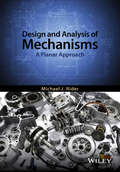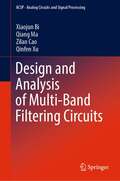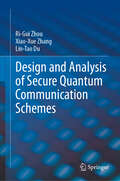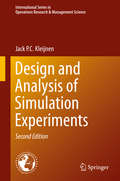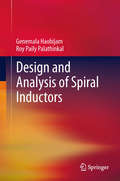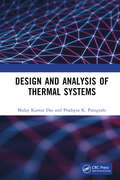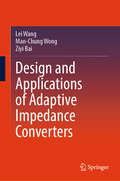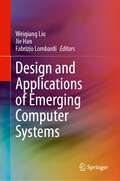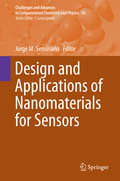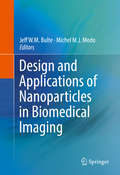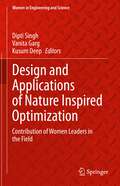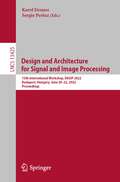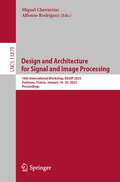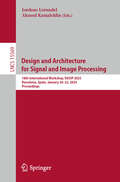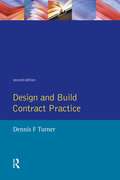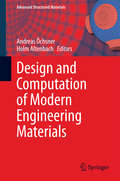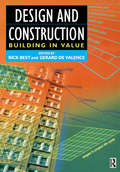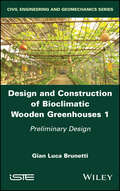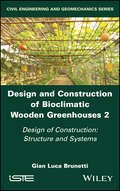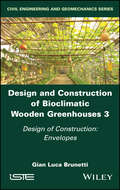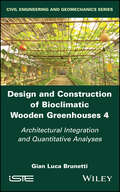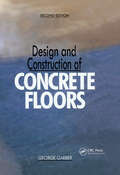- Table View
- List View
Design and Analysis of Mechanisms
by Michael RiderA planar or two-dimensional (2D) mechanism is the combination of two or more machine elements that are designed to convey a force or motion across parallel planes. For any mechanical engineer, young or old, an understanding of planar mechanism design is fundamental. Mechanical components and complex machines, such as engines or robots, are often designed and conceptualised in 2D before being extended into 3D. Designed to encourage a clear understanding of the nature and design of planar mechanisms, this book favours a frank and straightforward approach to teaching the basics of planar mechanism design and the theory of machines with fully worked examples throughout. Key Features: Provides simple instruction in the design and analysis of planar mechanisms, enabling the student to easily navigate the text and find the desired material Covers topics of fundamental importance to mechanical engineering, from planar mechanism kinematics, 2D linkage analyses and 2D linkage design to the fundamentals of spur gears and cam design Shows numerous example solutions using EES (Engineering Equation Solver) and MATLAB software, with appendices dedicated to explaining the use of both computer tools Follows end-of-chapter problems with clearly detailed solutions
Design and Analysis of Mechanisms: A Planar Approach
by Michael J. RiderA planar or two-dimensional (2D) mechanism is the combination of two or more machine elements that are designed to convey a force or motion across parallel planes. For any mechanical engineer, young or old, an understanding of planar mechanism design is fundamental. Mechanical components and complex machines, such as engines or robots, are often designed and conceptualised in 2D before being extended into 3D. Designed to encourage a clear understanding of the nature and design of planar mechanisms, this book favours a frank and straightforward approach to teaching the basics of planar mechanism design and the theory of machines with fully worked examples throughout. Key Features: Provides simple instruction in the design and analysis of planar mechanisms, enabling the student to easily navigate the text and find the desired material Covers topics of fundamental importance to mechanical engineering, from planar mechanism kinematics, 2D linkage analyses and 2D linkage design to the fundamentals of spur gears and cam design Shows numerous example solutions using EES (Engineering Equation Solver) and MATLAB software, with appendices dedicated to explaining the use of both computer tools Follows end-of-chapter problems with clearly detailed solutions
Design and Analysis of Multi-Band Filtering Circuits (Analog Circuits and Signal Processing)
by Xiaojun Bi Qiang Ma Zilan Cao Qinfen XuThe book systematically introduces the design theory and method of multi-band RF filtering circuits for the modern wireless communication systems or radar systems, which are required to operate at multi-bands. These multi-band filtering RF circuits have drawn more and more attention from the engineers and scientists in the field of RF circuits design. The book proposes the detailed theoretical analysis and abundant experimental data of multi-mode resonators, multi-band bandpass filter with high selectivity, reflectionless multi-band bandpass filter, balanced filter with high suppression, slotline based multi-band balun filter, switchable filtering diplexer based on reused L-shape resonator and miniaturized 55-/95-GHz on-chip dual-band bandpass Filter.The book is intended for undergraduate and graduate students who are interested in filtering circuits design, researchers who are investigating RF & microwave systems, as well as design engineers who are working in the RF & microwave circuits field. Readers can get an in-depth understanding about the multi-band RF filtering circuits design theory and method.
Design and Analysis of Reinforced Fiber Composites
by Pedro V. Marcal Nobuki YamagataThe papers in this volume present a broad range of applications for reinforced fiber composites - from thin shell structures to tires. Linear and nonlinear structural behavior (from linear buckling to nonlinear yelding and fracture) are discussed as well as different materials are presented. Latest developments in computational methods for constructíons are presented which will help to save money and time. This is an edited collection of papers presented at a symposium at the WCCM, Barcelona, 2014.
Design and Analysis of Secure Quantum Communication Schemes
by Ri-Gui Zhou Xiao-Xue Zhang Lin-Tao DuThis book provides a comprehensive guide to the design and analysis of quantum secure communication schemes. While quantum computers may provide a platform for arithmetic calculations which threaten classical cryptosystems, the development of quantum information has also brought a corresponding solution: quantum cryptography, which is the basis of quantum secure communication. Quantum secure communication (QSC) uses quantum states for key agreement and information transmission, and uses the basic principles of quantum mechanics to discover eavesdropping behavior, and to ensure the security of information. It can overcome the security risks of classical encryption technology and can securely distribute keys in real time via public channels. Beginning in 1984 with the first conception of quantum key distribution (QKD) based on single-photon polarization states, subsequent innovations include quantum identity authentication (QIA), quantum secret sharing (QSS), quantum direct communication (QDC), quantum key agreement (QKA), quantum private query (QPQ), and quantum network coding (QNC). Each of these schemes is explored in detail based on different environments and structures, along with specific security and feasibility analyses. This book is essential reading for academic researchers and graduate students in quantum science and technology, as well as professionals and engineers in quantum industries and cybersecurity.
Design and Analysis of Simulation Experiments
by Jack P.C. KleijnenThis is a new edition of Kleijnen's advanced expository book on statistical methods for the Design and Analysis of Simulation Experiments (DASE). Altogether, this new edition has approximately 50% new material not in the original book. More specifically, the author has made significant changes to the book's organization, including placing the chapter on Screening Designs immediately after the chapters on Classic Designs, and reversing the order of the chapters on Simulation Optimization and Kriging Metamodels. The latter two chapters reflect how active the research has been in these areas. The validation section has been moved into the chapter on Classic Assumptions versus Simulation Practice, and the chapter on Screening now has a section on selecting the number of replications in sequential bifurcation through Wald's sequential probability ration test, as well as a section on sequential bifurcation for multiple types of simulation responses. Whereas all references in the original edition were placed at the end of the book, in this edition references are placed at the end of each chapter. From Reviews of the First Edition: "Jack Kleijnen has once again produced a cutting-edge approach to the design and analysis of simulation experiments. " (William E. BILES, JASA, June 2009, Vol. 104, No. 486)
Design and Analysis of Spiral Inductors
by Genemala Haobijam Roy Paily PalathinkalThe book addresses the critical challenges faced by the ever-expanding wireless communication market and the increasing frequency of operation due to continuous innovation of high performance integrated passive devices. The challenges like low quality factor, design complexity, manufacturability, processing cost, etc., are studied with examples and specifics. Silicon on-chip inductor was first reported in 1990 by Nguyen and Meyer in a 0.8 μm silicon bipolar complementary metal oxide semiconductor technology (BiCMOS). Since then, there has been an enormous progress in the research on the performance trends, design and optimization, modeling, quality factor enhancement techniques, etc., of spiral inductors and significant results are reported in literature for various applications. This book introduces an efficient method of determining the optimized layout of on chip spiral inductor. The important fundamental tradeoffs of the design like quality factor and area, quality factor and inductance, quality factor and operating frequency, maximum quality factor and the peak frequency is also explored. The authors proposed an algorithm for accurate design and optimization of spiral inductors using a 3D electromagnetic simulator with minimum number of inductor structure simulations and thereby reducing its long computation time. A new multilayer pyramidal symmetric inductor structure is also proposed in this book. Being multilevel, the proposed inductor achieves high inductance to area ratio and hence occupies smaller silicon area.
Design and Analysis of Thermal Systems
by Malay Kumar Das Pradipta K. PanigrahiThermal systems are essential features of all domestic and industrial applications involving heat and fluid flow. Focusing on the design of thermal systems, this book bridges the gap between the theories of thermal science and design of practical thermal systems. Further, it discusses thermodynamic design principles, mathematical and CFD tools that will enable students as well as professional engineers to quickly analyze and design practical thermal systems. The major emphasis is on practical problems related to contemporary energy- and environment-related thermal systems including discussions on computational fluid dynamics used in thermal system design. Features Exclusive book integrating thermal sciences and computational approaches Covers both philosophical concepts related to systems and design, to numerical methods, to design of specific systems, to computational fluid dynamics strategies Focus on solving complex real-world thermal system design problems instead of just designing a single component or simple systems Introduces usage of statistics and machine learning methods to optimize the system Includes sample PYTHON codes, exercise problems, special projects This book is aimed at senior undergraduate/graduate students and industry professionals in mechanical engineering, thermo-fluids, HVAC, energy engineering, power engineering, chemical engineering, nuclear engineering.
Design and Applications of Adaptive Impedance Converters
by Lei Wang Man-Chung Wong Ziyi BaiThis book provides the potential advantages of adaptive impedance converters in different applications, such as power quality compensations, AC/DC microgrids, co-phase railway traction supply systems, and underwater electroacoustic transduction systems. In these applications, the adaptive impedance converter models, topologies, and control methods are introduced in this book. Adaptive impedance converters are designed to transform the impedance of an electronic system to optimize its performance. The adaptive impedance converter is typically implemented using passive and active electronic components to achieve impedance transformation. The main advantage of adaptive impedance converters is their ability to dynamically adjust the impedance to optimize system performance, which can help improve signal quality, reduce interference, and minimize power losses. Whether it is passive based adaptive impedance converters and active adaptive impedance, they both can applied into different applications including distribution system, renewable energy integration, AC/DC microgrids, traction supply system, and power amplifiers to achieve good performances and ensure efficient power transfer. The passive-based adaptive impedance converters can effectively reduce the converter rating and power loss, maintaining a large operational range. The active adaptive impedance can change its impedance varying with frequency, load conditions, or other factors to match the impedance of the source or load, providing efficient power transfer and minimizing signal reflections. The target audience of this book is the research scholars (including master’s and Ph.D. students) in power electronics and electrical engineer.
Design and Applications of Emerging Computer Systems
by Jie Han Weiqiang Liu Fabrizio LombardiThis book provides a single-source reference to the state-of-the-art in emerging computer systems. The authors address the technological contributions and developments at various hardware levels of new systems that compute under novel operational paradigms such as stochastic, probabilistic/inexact, neuromorphic, spintronic, bio-inspired and in-memory computing. Coverage includes the entire stack, i.e., from circuit, architecture, up to system level. This book includes tutorials, reviews and surveys of current theoretical/experimental results, design methodologies and a range of applications.
Design and Applications of Nanomaterials for Sensors
by Jorge M. SeminarioDesign and Applications of Nano materials for Sensors begins with an introductory contribution by the editors that: gives an overview of the present state of computational and theoretical methods for nanotechnology; outlines hot topics in this field and points to expected developments in the near future. This general introduction is followed by 15-30 review chapters by invited experts who have substantially contributed to the recent developments of nano materials for sensors. Guided by molecular and quantum theories, this contributed volume gives a broad picture of the current and past advances that were necessary to develop nano sensors using nano materials. To illustrate the important and relevant applications of nano materials, Design and Applications of Nano materials for Sensors focuses on recent advances that extend the scope of possible applications of the theory, improve the accuracy with respect to experimentation and reduce the cost of these calculations. This volume also features new applications of theoretical chemistry methods to problems of recent general interest in nanotechnology whereby large computational experiments are now necessary.
Design and Applications of Nanoparticles in Biomedical Imaging
by Jeff W.M. Bulte Michel M.J. ModoThis book covers the state-of-the-art technology of using nanoparticles in biomedical imaging, including magnetic resonance imaging, nuclear medicine, ultrasound imaging, computed tomography, and optical imaging. Topics include nanoparticles for magnetic particle imaging (MRI), siRNA delivery, theranostic nanoparticles and PET imaging of drug delivery, US nanoparticles for drug delivery, inorganic nanoparticles for targeted CT imaging, and quantum dots. This book serves as a valuable resource on the fundamental science of diagnostic nanoparticles in their interactions with biological targets, providing a platform technology for clinical implementation and improved detection of disease. This book also: Broadens readers' understanding of optical imaging, including fluorescent nanoparticles for the visualization of protein trafficking and hyperspectral microscopy using colloidal quantum dots Covers the latest developments in computing tomography, from inorganic nanoparticles for targeted CT imaging to metal-based nanoparticles for CT imaging Shares many insights into the state-of-the-art in ultrasound imaging, such as US bubbles, cell tracking and US nanoparticles for drug delivery Enriches readers' understanding of the most up-to-date technology in using PET nanoparticles to target tumor metastasis, PET imaging of drug delivery, and Nanoparticles for magnetic particle imaging (MRI)
Design and Applications of Nature Inspired Optimization: Contribution of Women Leaders in the Field (Women in Engineering and Science)
by Kusum Deep Dipti Singh Vanita GargThis book gives a detailed information of various real-life applications from various fields using nature inspired optimization techniques. These techniques are proven to be efficient and robust in many difficult problems in literature. The authors provide detailed information about real-life problems and how various nature inspired optimizations are applied to solve these problems. The authors discuss techniques such as Biogeography Based Optimization, Glow Swarm Optimization, Elephant herd Optimization Algorithm, Cuckoo Search Algorithm, Ant Colony Optimization, and Grey Wolf Optimization etc. These algorithms are applied to a wide range of problems from the field of engineering, finance, medicinal etc. As an important part of the Women in Science and Engineering book series, the work highlights the contribution of women leaders in nature inspired optimization, inspiring women and men, girls and boys to enter and apply themselves to the field.
Design and Architecture for Signal and Image Processing: 15th International Workshop, DASIP 2022, Budapest, Hungary, June 20–22, 2022, Proceedings (Lecture Notes in Computer Science #13425)
by Karol Desnos Sergio PertuzThis book constitutes the thoroughly refereed conference proceedings of the First International Workshop on Design and Architecture for Signal and Image Processing, DASIP 2022, held in Budaypest, Hungary in June 2022. The 13 full included in the volume were carefully reviewed and selected from 32 submissions. They are organized in the following topical sections: leading signal, image and video processing and machine learning in custom embedded, edge and cloud computing architectures and systems.
Design and Architecture for Signal and Image Processing: 16th International Workshop, DASIP 2023, Toulouse, France, January 16–18, 2023, Proceedings (Lecture Notes in Computer Science #13879)
by Miguel Chavarrías Alfonso RodríguezThis book constitutes the thoroughly refereed conference proceedings of the 16th International Workshop on Design and Architecture for Signal and Image Processing, DASIP 2023, held in Toulouse, France in January 2023.The 9 full included in the volume were carefully reviewed and selected from 17 submissions. They are organized in the following topical sections: Methods and Applications, Hardware Architectures and Implementations and others.
Design and Architecture for Signal and Image Processing: 18th International Workshop, DASIP 2025, Barcelona, Spain, January 20–22, 2025, Proceedings (Lecture Notes in Computer Science #15569)
by Jordane Lorandel Ahmed KamaleldinThis book constitutes the refereed conference proceedings of the 18th International Workshop on Design and Architecture for Signal and Image Processing, DASIP 2025, held in Barcelona, Spain, during January 20-22, 2025. The 10 full papers included in this book were carefully reviewed and selected from 23 submissions.They were organized in topical sections as follows: Specialized Hardware Architecture for Efficient Processing; Efficient Processing using AI for Image, Vision and Signal Applications, and Analysis of Emerging Techniques for Signal Processing Applications.
Design and Architectures for Signal and Image Processing: 17th International Workshop, DASIP 2024, Munich, Germany, January 17–19, 2024, Proceedings (Lecture Notes in Computer Science #14622)
by Tiago Dias Paola BusiaThis book constitutes the refereed proceedings of the 17th International Workshop on Design and Architecture for Signal and Image Processing, DASIP 2024, held in Munich, Germany, during January 17–19, 2024. The 9 full papers presented in this book were carefully reviewed and selected from 21 submissions. The workshop provided an inspiring international forum for the latest innovations and developments in the fields of leading signal, image, and video processing and machine learning in custom embedded, edge, and cloud computing architectures and systems.
Design and Build Contract Practice
by Dennis F. TurnerThis edition covers the principles of the design and build system of construction and examines the detail of the operation.
Design and Computation of Modern Engineering Materials
by Andreas Öchsner Holm AltenbachThe idea of this monograph is to present the latest results related to design and computation of engineering materials and structures. The contributions cover the classical fields of mechanical, civil and materials engineering up to biomechanics and advanced materials processing and optimization. The materials and structures covered can be categorized into modern steels and titanium alloys, composite materials, biological and natural materials, material hybrids and modern joining technologies. Analytical modelling, numerical simulation, the application of state-of-the-art design tools and sophisticated experimental techniques are applied to characterize the performance of materials and to design and optimize structures in different fields of engineering applications.
Design and Construction (Building In Value Ser.)
by Rick Best Gerard De ValenceThe design and construction of buildings is a lengthy and expensive process, and those who commission buildings are continually looking for ways to improve the efficiency of the process. In this book, the second in the Building in Value series, a broad range of topics related to the processes of design and construction are explored by an international group of experts. The overall aim of the book is to look at ways that clients can improve the value for money outcomes of their decisions to construct buildings. The book is aimed at students studying in many areas related to the construction industry including architecture, construction management, civil engineering and quantity surveying, and should also be of interest to many in the industry including project managers, property developers, building contractors and cost engineers.
Design and Construction of Bioclimatic Wooden Greenhouses, Volume 1: Preliminary Design
by Gian Luca BrunettiDesign and Construction of Bioclimatic Wooden Greenhouses, Volume 1: Preliminary Design
Design and Construction of Bioclimatic Wooden Greenhouses, Volume 2: Design of Construction: Structure and Systems
by Gian Luca BrunettiDesign and Construction of Bioclimatic Wooden Greenhouses, Volume 2: Design of Construction: Structure and Systems
Design and Construction of Bioclimatic Wooden Greenhouses, Volume 3: Design of Construction: Envelopes
by Gian Luca BrunettiDesign and Construction of Bioclimatic Wooden Greenhouses, Volume 3: Design of Construction: Envelopes
Design and Construction of Bioclimatic Wooden Greenhouses, Volume 4: Architectural Integration and Quantitative Analyses
by Gian Luca BrunettiDesign and Construction of Bioclimatic Wooden Greenhouses, Volume 4: Architectural Integration and Quantitative Analyses
Design and Construction of Concrete Floors
by George GarberDesign and Construction of Concrete Floors outlines the key principles needed for the production of a good floor which can be relied on to not only support and restrain other parts of the building, but also to meet the needs of the user.The book covers:* Uses of concrete floors* Structural design* Concrete used specifically for floors* Cracks and joints* Floor surface propertiesThis book is ideal for structural engineers and others in the building and design industry that want to use a balanced approach and look beyond structural strength in the design of a good floor.The book draws on both European and American experience, citing both British and US standards – all of which have been amended and updated since the last edition.
